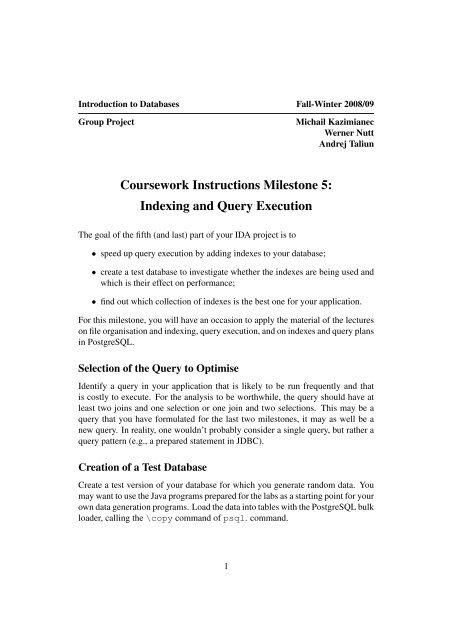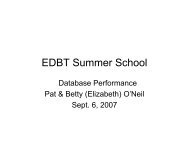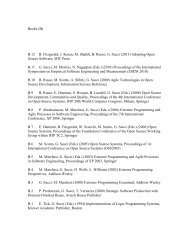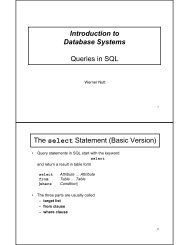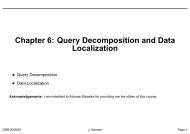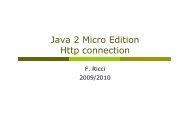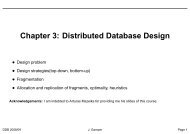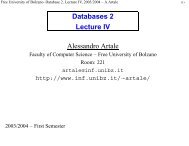Coursework Instructions Milestone 5: Indexing and Query Execution
Coursework Instructions Milestone 5: Indexing and Query Execution
Coursework Instructions Milestone 5: Indexing and Query Execution
Create successful ePaper yourself
Turn your PDF publications into a flip-book with our unique Google optimized e-Paper software.
Introduction to Databases Fall-Winter 2008/09<br />
Group Project<br />
Michail Kazimianec<br />
Werner Nutt<br />
Andrej Taliun<br />
<strong>Coursework</strong> <strong>Instructions</strong> <strong>Milestone</strong> 5:<br />
<strong>Indexing</strong> <strong>and</strong> <strong>Query</strong> <strong>Execution</strong><br />
The goal of the fifth (<strong>and</strong> last) part of your IDA project is to<br />
• speed up query execution by adding indexes to your database;<br />
• create a test database to investigate whether the indexes are being used <strong>and</strong><br />
which is their effect on performance;<br />
• find out which collection of indexes is the best one for your application.<br />
For this milestone, you will have an occasion to apply the material of the lectures<br />
on file organisation <strong>and</strong> indexing, query execution, <strong>and</strong> on indexes <strong>and</strong> query plans<br />
in PostgreSQL.<br />
Selection of the <strong>Query</strong> to Optimise<br />
Identify a query in your application that is likely to be run frequently <strong>and</strong> that<br />
is costly to execute. For the analysis to be worthwhile, the query should have at<br />
least two joins <strong>and</strong> one selection or one join <strong>and</strong> two selections. This may be a<br />
query that you have formulated for the last two milestones, it may as well be a<br />
new query. In reality, one wouldn’t probably consider a single query, but rather a<br />
query pattern (e.g., a prepared statement in JDBC).<br />
Creation of a Test Database<br />
Create a test version of your database for which you generate r<strong>and</strong>om data. You<br />
may want to use the Java programs prepared for the labs as a starting point for your<br />
own data generation programs. Load the data into tables with the PostgreSQL bulk<br />
loader, calling the \copy comm<strong>and</strong> of psql. comm<strong>and</strong>.<br />
1
Identification of Possible Indexes<br />
Identify different options to support the execution of the query by indexes. For<br />
each option,<br />
• specify which indexes need to be created for which attributes,<br />
• describe how you expect the indexes to be used by the query engine, that<br />
is, write up an execution plan, either textually or graphically, that would<br />
benefit from those indexes.<br />
For your query, you should explore at least two design options.<br />
Testing the Design Options<br />
First, run your query on the test database without indexes <strong>and</strong> measure the time<br />
(EXPLAIN ANALYZE may be useful for doing this).<br />
Then create the indexes for the first option. Use EXPLAIN, possibly in pgAdmin,<br />
to check whether the indexes are employed in the way you have foreseen. If<br />
this is the case, take measurements. If not, modify your index design.<br />
Then drop the indexes <strong>and</strong> test the second option in a similar way.<br />
If you have chosen a parameterized query, make sure that you test the design<br />
for a sufficient number of paramenters. It may be the case that the optimiser<br />
chooses different plans, depending on the parameter.<br />
Based on your findings, explain which is the best choice of indexes for your<br />
query.<br />
It is not a problem if your test results are different from what you expected.<br />
The point of the exercise is to explore how the query optimiser works.<br />
Deliverable<br />
The deliverable will be a document consisting of four parts:<br />
1. a section introducing the query you want to optimise <strong>and</strong> a short explanation<br />
why it is important;<br />
2. a section describing the test database: size of relations, number of different<br />
values for an attribute, the choice of the range of values, etc.;<br />
3. a section presenting the design options you explore;<br />
4. a section reporting on the test results.<br />
2
Deadline <strong>and</strong> Submission<br />
The work is to be submitted by publishing it on the web site of your IDA group.<br />
The deadline is<br />
Monday, 2 February 2009, 7pm.<br />
3


